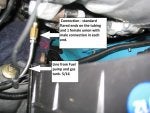your picture shows tube nuts with presumably flared ends on your metal lines. these will leak robustly if the ends are not flared properly, evenly, and at the same angle as the brass connectors. same thing with brake lines. If you have metal lines with flared ends, you can take regular fuel rubber hose and just put it over the ends of the metal lines with hose clamps. It is not the right way to do it, but if the system is a low pressure system with a carburetor, it will work fine (and has worked fine for 20 years on one of my cars).
the question is what is the end flare on your metal lines, and who flared it? if you did it yourself with one of those cheap flaring tools after you cut the lines yourself with a tubing cutter, odds are the flared ends are not symmetric -- when using a tubing cutter (one of those metal wheels you twist around the tube while you tighten it), you harden the end of the metal line, so that when you flare it, it flares unevenly. I made up all my own brake lines and it took me two or three tries on each fitting before i figured it out. Using a small cutoff wheel on a dremel tool does not harden the ends, and gives you good flares. maybe I am off topic here.







